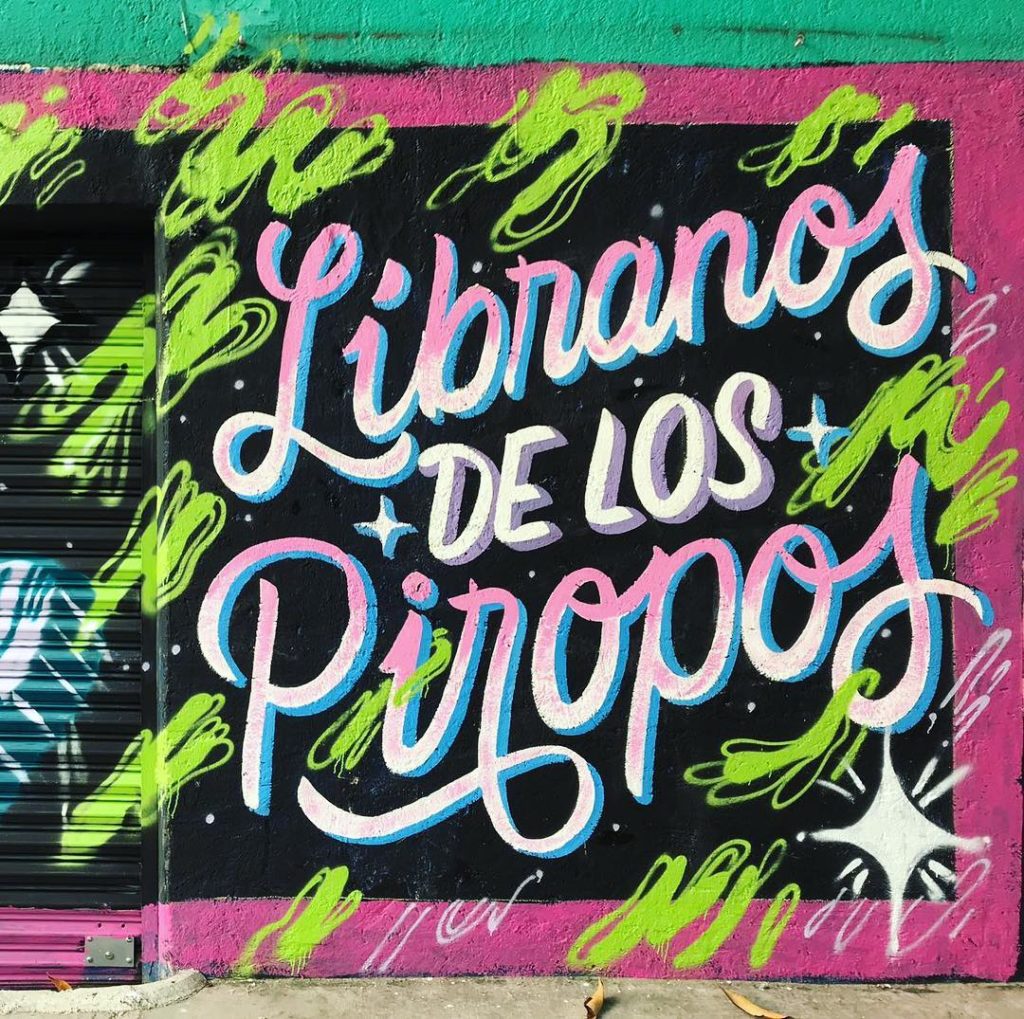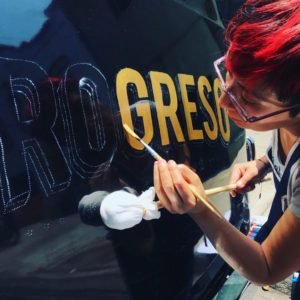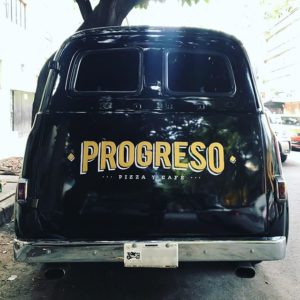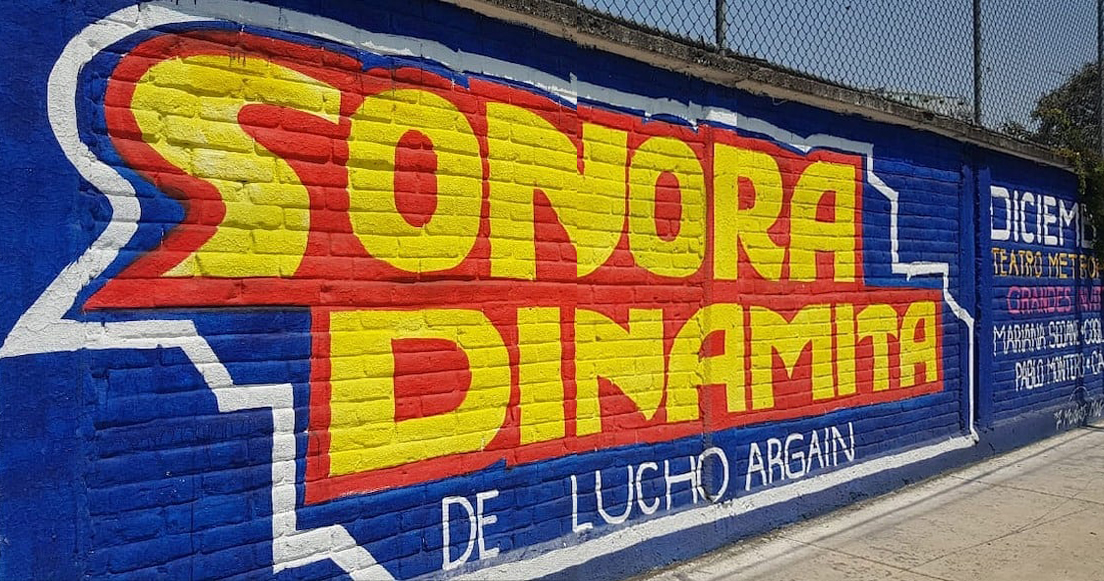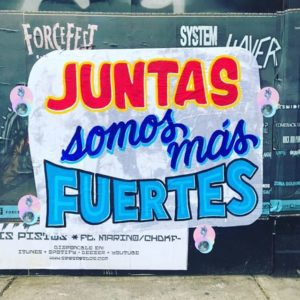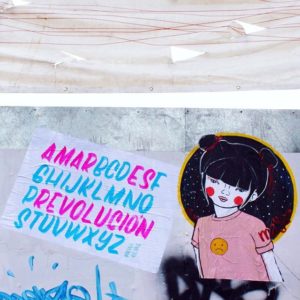To read this post in English, keep scrolling or go here.
Alina es una pequeña gran fuerza de la naturaleza. Su trabajo, como artista de la rotulación, se extiende a lo ancho y largo de su natal México.
Preserva la tradición del rótulo vernacular, típico del paisaje urbano de la Ciudad de México, combinándolo con mensajes poderosos que buscan la conciencia social o simplemente alegrar el día a día de los transeúntes que logran toparse con alguno de sus trabajos, pues los rótulos de Alina, van desde piezas personales hasta muros que coquetean con el graffiti.
El amor, el respeto y la igualdad son el tipo de temáticas que Alina considera básicas en nuestra sociedad y que busca plasmar en sus mensajes. Forma parte del movimiento Paste Up Morras, una comunidad de mujeres que pegan en las calles propaganda ilegal con temas como el feminismo, la igualdad y el respeto. Creada por y para mujeres que se sentían inseguras en el medio de street art o graffiti ilegal, prácticas estigmatizadas en nuestro país. Salir en grupo se ha convertido en una experiencia segura para sus integrantes y ha generado alrededor de esta actividad una comunidad de artistas, que se desarrollan con mayor seguridad y confianza. De la mano con esto, también ha creado un proyecto que aborda frases en apoyo a la mujer a partir de reflexiones propias y escuchando a otras mujeres hablar sobre los distintos tipos de discriminación que han sufrido. Así, las calles de nuestra ciudad se han ido llenando de expresiones que invitan a la reflexión, manifestando un sentido de unidad femenina, una bocanada de aire fresco en una sociedad donde los temas y políticas de igualdad y derechos para la mujer se mezclan día a día con la injusticia social, los feminicidios y la impunidad.
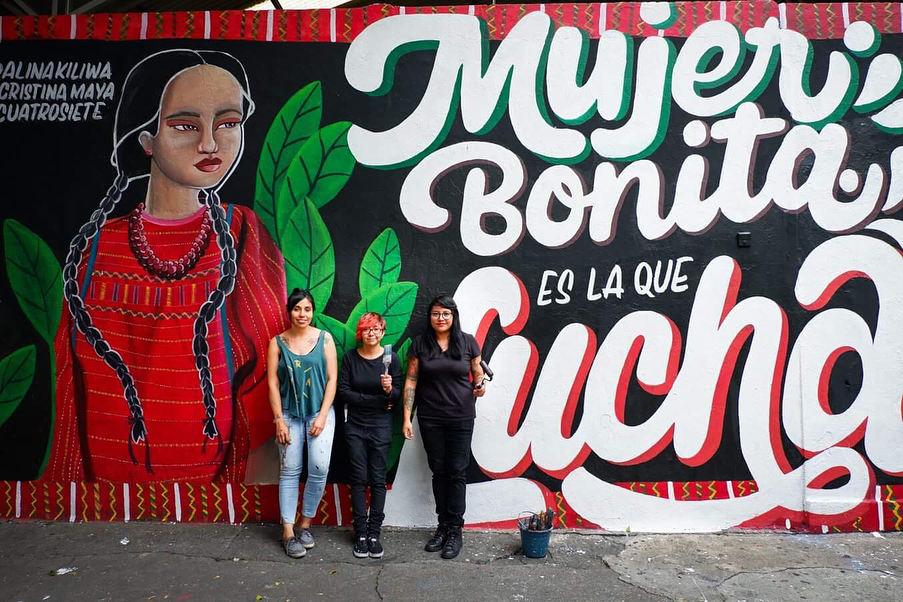
“Pretty woman is the one who fights” project coworked with @cuatrosiete and @ cristinamaya02 for the project @jovenesartesanos. Alina is in the middle.
Dedicated to the Triquis women of Juxtlahuaca, Oaxaca.
Su camino en la búsqueda del aprendizaje y el dominio de la técnica ha transcurrido desde estudios en diseño gráfico y cursos formales de caligrafía y lettering, hasta el autodidacta aprendizaje en las calles sólo mirando e imitando a los maestros del rótulo tradicional, quienes a pesar de su dominio de la técnica no conciben un método de enseñanza al respecto y por lo mismo solo ofrecen dejarte mirar su trabajo.
Las piezas de Alina se caracterizan por una paleta llena de colores, su estilo favorito es el casual con pincel, ella se muestra alegre, realista pero muy optimista, se define así misma como amante de la música y su interés yace en hacer las cosas con amor.
Platicamos con ella para conocer más sobre sus orígenes e inquietudes:
Sabemos que tu nombre es Alina Soria, no podemos evitar preguntar ¿Por qué Kiliwa?
A: Alina Kiliwa fue un nombre que puse en mi Facebook hace 10 años para no tener mi nombre real y con el paso del tiempo así se quedó. Empecé a hacer letras hace 7 años y después todos me reconocían así. Nunca pensé que tuviera importancia hasta que todos comenzaron a llamarme como Kiliwa.
¿Cómo te iniciaste en el lettering y el rotulismo?
A: Desde niña siempre me gustaron los rótulos en la calle, por eso decidí estudiar diseño gráfico, después busqué alguna escuela o taller en donde pudiera aprender rótulos en México pero no encontré, fue así que decidí tomar talleres de caligrafía en la Sociedad de Calígrafos e Iluminadores con Antonio Anzures, después tome algunos otros talleres especializados con Ale Paul, entre otros como Gabriel Martínez Meave, Erick de la Rosa, etc.
¿Quienes son tus referencias o fuentes de inspiración?
A: Siempre han sido y serán los rotulistas mexicanos de bardas de baile y también Eliot Tupac de Perú.
¿Cuál es el proceso de creación que llevas a cabo?
A: Antes que nada busco una frase o palabra que me signifique algo y pienso que puede generar alguna reflexión en los espectadores, luego el proceso de bocetaje puede ser digital en iPad o en cualquier papel, desde hace unos meses trato de dejar todos mis bocetos en digital para no perderlos en papelitos sueltos. Después dependiendo de si es mural, cartel o imagen digital decido el siguiente paso.
¿Cual consideras que es tu mayor reto durante la elaboración de uno de tus murales o pieza de rotulismo?
A: El formato en grande siempre ha sido un reto porque debes ser muy precisa en los trazos y líneas guía y el trabajar en las alturas en grúas, andamios, hamacas, también ha sido un gran reto.
- Alina working on a lettering piece
- “Progress”
¿Qué es lo que más te gusta de tu trabajo?
A: Que todos los días aprendo algo nuevo, en cuestiones de materiales, soportes, acabados, etc.
¿Cuál ha sido el más grande reto en el desarrollo de tu carrera?
A: Aprender de manera autodidacta el uso de los materiales que usan los rotulistas, desde conocer cuales son los pinceles adecuados, cómo trazar y marcar, cuál es la la diferencia entre las pinturas, aerosoles.
¿Crees que el factor de ser mujer ha implicado algún tipo de complicación o un reto mayor en el área específica en que te desarrollas?
A: El hecho de ser mujer te obliga a ser el doble de buena para que te volteen a ver o les guste tu trabajo, es un reto que día a día voy sorteando. Ahora lo veo como una ventaja, pues creo que el ser mujer y de estatura pequeña me ha obligado a esforzarme más y es ese esfuerzo extra, lo que me ha llevado a pulir mis conocimiento y habilidades.
¿En qué estás trabajando ahora y cuales son tus planes o inquietudes para el futuro próximo?
A: Quisiera empezar a realizar obra artística con las técnicas aprendidas haciendo un enfoque y tributo a la gráfica popular mexicana de los rótulos, también quisiera viajar a otros países, a escuelas especializadas en rotulación o signpainter.
Poco a poco el trabajo de Alina ha comenzado a llamar la atención de los medios locales, la popularidad de sus proyectos también ha ido en aumento gracias sus redes sociales a las que alimenta de manera constante y natural. Procura su presencia en eventos afines, dicta talleres, charlas y conferencias en congresos nacionales y escuelas de diseño para seguir propagando el aprendizaje del rótulo y mantener viva la tradición, pero sobre todo sigue en una constante búsqueda del aprendizaje para profundizar en las letras y mejorar sus proyectos. Para conocer más sobre su trabajo, puedes seguirla en:
Instagram/ FB: @alinakiliwa
Never stop painting. An Interview with Alina Kiliwa
Alina is a great little force of nature. Her work, as a lettering artist, extends the width and length of her native Mexico.Her work preserves the tradition of the vernacular sign, typical of the urban landscape of Mexico City. She combines with powerful messages aiming for social conscience and brightens the day of pedestrians who get to see her pieces through the the streets. The signs of Alina range from personal pieces to entire walls that flirt with the city’s graffiti.
Love, respect and equality are the kind of themes that Alina considers basic in our society and that she seeks to capture in her messages. She is part of the Paste Up Morras movement, a community of women who infuse illegal propaganda on the streets with topics such as feminism, equality and respect. These are created by and for women who feel insecure in the making of street art or illegal graffiti, practices that are very stigmatized in our country. Going out in a group has generated a community of women artists who work together and feel safe. Alina also develops a project that addresses phrases in support of women. These phrases come from her own reflections while listening to other women talking about the different types of discrimination they have suffered. The streets of our city have been filled with phrases that invite reflection and express a sense of female unity, a breath of fresh air in a society where the issues and policies of equality and rights for women are mixed day to day with social injustice, femicides, and impunity.
Her path in the pursuit of learning and mastering the technique has gone from studies in graphic design and formal courses in calligraphy and lettering, to self-taught learning in the streets by just looking and imitating the masters of the traditional sign. Despite their mastery of technique, they don’t always conceive a method of teaching it and therefore they only offer to let you look at their work. Alina’s pieces are characterized by a palette full of colors. Her favorite style is casual with a brush. She is cheerful, realistic but very optimistic, and defines herself as a lover of music and of doing things with love.
We talked with her to learn more about her background and process:
We know that your real name is Alina Soria, we can’t help but ask why Kiliwa?
A: Alina Kiliwa was a name that I put on my Facebook 10 years ago to not have my real name and with the passage of time it stayed that way. I started making letters 7 years ago and then everyone recognized me like that. I never thought it mattered until everyone started calling me Kiliwa.
How did you start in lettering and labeling?
A: Since I was a little girl I always liked the signs on the street, so I decided to study graphic design, then I looked for a school or workshop where I could learn vernacular lettering in Mexico but I did not find it, so I decided to take calligraphy workshops at the Society of Calligraphers and Illuminators with Antonio Anzures, then I took some other specialized workshops with Ale Paul, among others such as Gabriel Martínez Meave, Erick de la Rosa, etc.
Who are your references or sources of inspiration?
A: They have always been and will be the Mexican signwalls of Street dance and also Eliot Tupac from Peru. (http://www.elliottupac.com/category/todo/)
What is the process of creation that you carry out?
A: First of all I look for a phrase or word that means something to me and I think it can generate some reflection in the viewers, then the process of sketching can be digital on iPad or on any paper, lately I try to leave all my sketches in digital to avoid losing them in loose pieces of paper. Then depending on whether it is a mural, poster or digital image, I decide the next step.
What do you consider your greatest challenge during the elaboration of one of your murals or piece of labeling?
A: The large format has always been a challenge because you must be very precise in the lines and guidelines and working on the heights in cranes, scaffolding, hammocks, has also been a great challenge.
Do you think that the factor of being a woman has involved some kind of complication or a greater challenge in the specific area in which you develop?
A: I think the fact of being a woman forces you to be twice as good as a man, just to make the others turn and see or like your work, it is a challenge that I draw every day. Actually, now I see it as an advantage, because I believe that being a woman and of small height has forced me to try harder and it is that extra effort, which has led me to improve my knowledge and skills.
What are you working on now and what are your plans or concerns for the near future?
A: I would like to start doing artistic works with the techniques I learned focusing on and paying tribute to the popular Mexican graphics, I would also like to travel to other countries, to schools specialized in lettering.
- “Together we are stronger”
- “To love is a revolution”
Little by little, Alina’s work has begun to attract the attention of local media. The popularity of her projects has also been increasing thanks to her social networks, which she feeds in a constant and natural way. She attends related events, offers workshops, and lectures at national conferences and design schools to continue spreading the learning of the vernacular lettering and keep the tradition alive. But above all, she’s on a constant search to learn more and to immerse that knowledge into her letters.
To know more about her work, you can follow her on:
Instagram / FB: @alinakiliwa
